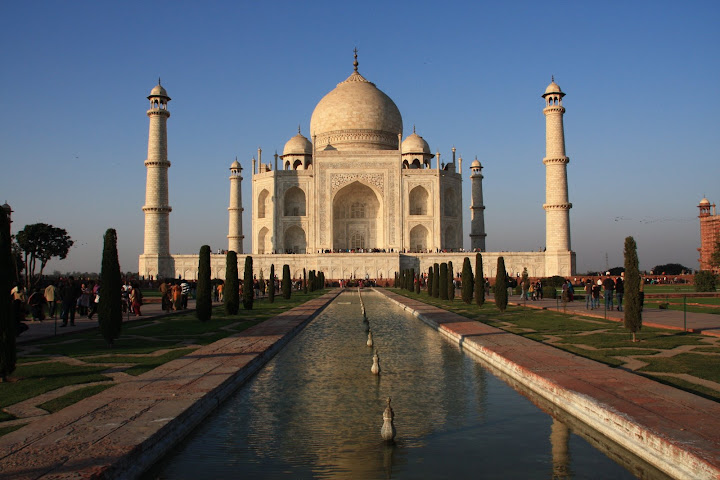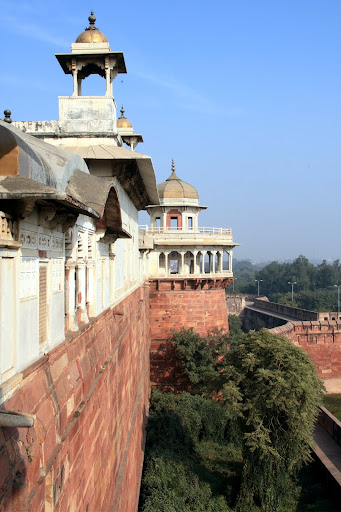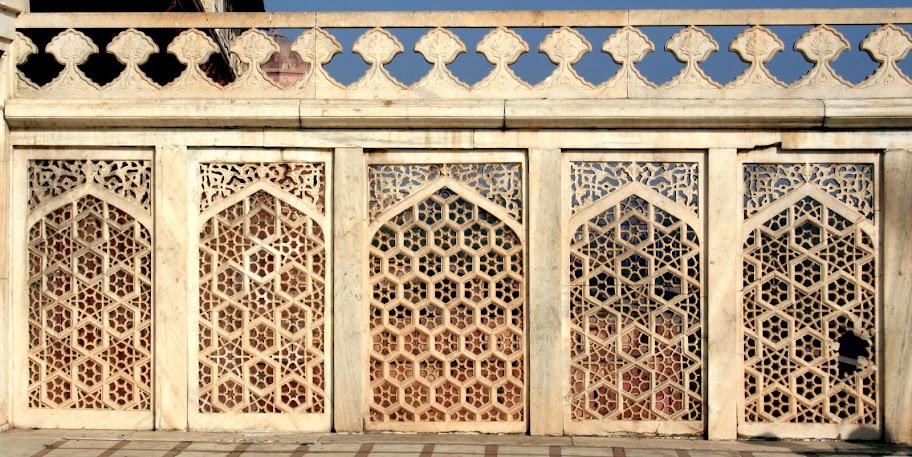
The first "real" Indian city we went to, Delhi is just so much larger that a number of things don’t apply in the same way. Of course, thanks to the Taj Mahal, it is also the largest or second largest tourist attraction in India, so not all things that apply to similarly sized cities like Bhopal and Indore are also true in Agra.
(pictures)
The first two things that stand out are the masses of people, and the comparative lack of infrastructure. Agra has between 1.3 and 3 million people, but you wouldn’t be able to tell from the city center which is more like a city of 50000 in most other parts of the world: no buildings over 4 stories, one shopping mall, and many things that are falling down. You also start noticing things that just aren’t there.
Agra's real size only became apparent the next day when it took an hour to reach the outskirts in our bus. But it's in line with the other cities we went to in MP and UP--come to think of it, Delhi's city center and infrastructure is maybe similar to Indianapolis or Springfield, IL.
Or things that are just baffling. For example, I never expected to hear the words "This town’s OTHER ATM is down this street." in a city this size. The town’s main ATM only dispensed 100RS notes--about $2. It’s quite a feeling to take out $100 and ending up with a stack of money you can hardly fold in half.
In general, Indian cities resemble ant hills--and I don’t mean this in an disparaging way. The overwhelming impression is dense masses of people, mostly on foot, and apparent chaos that only slowly shows any apparent order. On the other hand, there are old buildings and places of amazing beauty. It's more crowded than other towns in Asia, except maybe Osaka's train station or Shinjuku Station in Tokyo, but also feels incredibly alive. And strangely peaceful and comforting. Crowds like this in the US would end up in a riot in minutes, here it's just a normal day. Nobody yells, people rush past each other without touching, or they move people out off the way with a slight push with their right hands.
The other thing I’ve never seen before is how close the rich and the poor goes together. Even in Peru, there is usually a block between a "good area" and a bad one. Here the squatter city for the people who do marginal jobs for the guests like taking the laundry to the river and washing it by banging it against flat stones is right on the back of the walled garden of the 6 star Oberoi hotel.
The first place to visit in the morning was the Red Fort, a huge areal of red sandstone and marble with an unbelievable amount of decoration and artisan detail. (Some historians claim that it took 1.4 million laborers 8 years to construct in the 1570s.)
 It is unlike anything you see in any other part of the world: entire halls made of solid marble and inlaid with semi-precious stones, filigreed windows screens carved out of one piece of marble or sand stone, and much more jaw-droppingly beautiful design.
It is unlike anything you see in any other part of the world: entire halls made of solid marble and inlaid with semi-precious stones, filigreed windows screens carved out of one piece of marble or sand stone, and much more jaw-droppingly beautiful design.

After the fort, three others and I took our first TukTuk to ride out to the so-called Baby Taj. TukTuks are marginally less terrifying than rickshaws. Due to congestion, they also drive slower than their Thai or Peruvian equivalents, but are prone to more abrupt maneuvers, since Indian traffic is even more unpredictable that Thai. The sights include all kinds of animals, children playing real life Frogger, and the occasional dead body being carried on a stretcher. At the big traffic circle in front of the main bridge, we ran into a particularly ingenious method of traffic control : a few cops standing in the middle of the road and deciding on the fly which lane should move. If a driver ignores the signals—which commonly happens—they don’t hand out tickets, but just hit the vehicles hard enough with their lathis (5 foot bamboo batons) to put bumps into cars and raise welts on cyclists.
In a sign we overpaid for the TukTuk ride, our drivers were eager to wait for an hour until we finished visiting the Baby Taj.
The Baby Taj is the most singularly beautiful building I have ever seen. It is far smaller than the Taj Mahal, but while the Taj seems pretentious, the baby is of exquisite craftsmanship and impeccable design. It seemed even more improbable after we visited a inlay factory and heard that creating a dinner plate sized piece can take a skilled worker a month—I can’t even calculate how many man hours did go into doing this on a 50 by 50 foot building.
On the other hand, semi-domesticated water buffalo were fording the river right in front of it.
After the Red Fort and the Itmad, the Taj, although much larger and probably Asias most iconic building, was a bit of a letdown. The walls are plain marble inlaid only with some large Koran quotations, and very sterile. No wonder Shah Jahan’s son disposed him soon after the building was finished and nixed the plans for a sister building made of black marble.


























